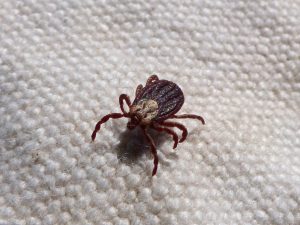Warmer weather means participating in fun outdoor activities like hiking, camping, and backyard barbeques. However, you may notice an increase in insects as you head outside this summer.
Unfortunately, many common summer pests like ticks are prone to spreading diseases. These pesky insects can attach themselves to you without notice, leaving you with an itchy bite and forcing you to remove the tick yourself.
Some ticks are capable of spreading Lyme disease, but others like the wood tick can infect you with Rocky Mountain spotted fever, a dangerous and sometimes fatal disease.
Before you head outside this summer, check out these tips to identify, prevent, and treat wood tick bites.
Wood Tick Identification
You may know the wood tick by its other common name: the American dog tick. You’re more likely to encounter the wood tick along the east coast and areas in the south.
Most of the western United States is not inhabited by these pests, but you may spot some in some regions of California.
Brown dog ticks populate almost all of the country, while deer ticks primarily occupy the midwestern, southern, and eastern portions of the country.
There are around 90 different tick species in the United States, so it’s important to understand what species has bitten you if symptoms appear later.
Check out this video to help you differentiate between the different species of ticks.
Female Vs. Male Wood Tick
Most ticks that bite humans are female ticks. Male ticks don’t stick to a host for long and typically fall off after briefly feeding.
Female wood ticks are dark brown with a small white oval under their heads. Male wood ticks are similarly colored but have a spotted pattern on their backs.
Here is a comparison of a female and male wood tick.

Photo by Marc Pascual on Pixabay

Photo by Daniel Bahrmann on Pixabay
Wood Tick Prevention
As you head out during the summer months, you may encounter wood ticks outdoors. Check out these tips to help avoid these tiny critters and keep yourself protected.
Wear Appropriate Clothing
If you plan to hike or explore large forested areas, you should pack the right clothes for your trip. Wear thick, long socks and tuck the ends of your pants inside your socks to prevent ticks from crawling up your legs.
Try wearing long pants and long-sleeved shirts. While the weather may make this difficult, covering your body is the easiest way to prevent tick bites. Whatever clothes you wear, opt for lighter colors. It’s harder to spot a tick crawling on you if you sport dark threads.
Ticks can’t bite through fabric and will instead search for bare skin. This article can give you more information about lightweight outdoor clothing to keep you protected.
Watch Where You Walk or Hike
Some outdoor spaces are more prone to ticks than others. You can find these ticks in heavily wooded areas where they can easily feed on the wildlife.
If you are hiking or camping, stick to cleared-out or worn paths. Untraveled paths will potentially have more off these pests because of the limited foot traffic.
Ticks tend to live in tall grasses and could latch onto your clothing or legs. Always look for ticks after a walk outdoors to ensure nothing has hitched a ride.
Use a Tick Repellent
If you’re about to head out for a long hike, it could be a good idea to pack a bug spray. Many bug repellents work against ticks and can even prevent other bug bites.
Check options that are specifically formulated to prevent tick bites. Choose a spray that includes diethyltoluamide (DEET) and permethrin to prevent and kill ticks.
Protecting your Dogs and Cats
Your pets are more likely to struggle with tick bites, especially if they spend time outdoors. Dogs and cats can even occasionally catch many of the same tick-borne illnesses that humans can. In fact, wood ticks can transmit Rocky Mountain spotted fever, while other ticks can spread Lyme disease to cats and dogs.
It’s uncommon for pets to have these diseases, but ticks can infect your pets with other debilitating illnesses. Your pets can contract ehrlichiosis, canine babesiosis, and a host of other diseases from other ticks.
Finding a tick on your dog doesn’t mean they will catch an illness, but it makes them more susceptible to getting sick. Thankfully, there are ways to shield your pets from harm.
Medicated Shampoos
If you frequently take your dog on walks, try using a medicated shampoo designed to kill ticks. These shampoos can eliminate any ticks currently on your furry friend.
You should notice a decrease in ticks within 24 hours, but you may need to comb through your dog’s fur to remove any dead pests.
Shampoos won’t discourage ticks from latching onto your pets, but they can help take out any insects you find. If your pets frequently suffer from ticks, try a preventative method.
Tick collars
These collars act as a repellent to keep ticks from latching onto your pets. Some release chemicals that prevent ticks from biting areas around their neck, and others can spread the pet-friendly pesticide over your animal’s body.
Your animals should have a few months of protection from these pests. Because ticks are more prominent in warmer weather, place a collar on your pet as the weather heats up each year.
Prescribed Medication
If the other options aren’t cutting it, you can ask your vet to prescribe your pet oral tick control. There are options you can purchase from the pet store, but it wouldn’t hurt to get your doctor’s opinion before trying anything new.
Oral medications will impact a tick after they bite your pet. They can prevent ticks from reproducing or will completely kill the tiny arachnids.
You can directly apply a topical treatment to your pet’s skin, too. Make sure to place the medication in an area on your pet’s body that they cannot easily reach. If ingested, the treatment could make your pet sick.
Topical remedies will eliminate existing ticks and prevent others from harming your pet. Check out this post to learn more about the types of medicated treatments for your pet.
Is a Wood Tick’s Bite Dangerous?
Like most types of ticks, the wood tick can spread disease. You’re unlikely to get Lyme Disease from these pests, but you could contract Rocky Mountain spotted fever.
Rocky Mountain spotted fever can begin with seemingly insignificant symptoms. Infected individuals typically suffer from headaches, fever, nausea, and a rash that presents in the later stages of the infection.
If you quickly treat Rocky Mountain spotted fever, you should recover completely. A course of antibiotics will typically prevent any serious complications. However, if it is not treated swiftly, you could experience severe side effects.
You could suffer from internal damage like kidney failure or serious inflammation if the infection progresses unabated. While rare, it is fatal if not properly treated.
If you suspect that you have contracted Rocky Mountain spotted fever or any other tick-related illness, see a medical professional immediately.
How to Remove a Tick
If you spot one of these pests on you, you may want to remove it from your skin, but you must treat tick bites carefully. Correctly removing a tick will help prevent the spread of illness and ensure you don’t leave parts of the tick embedded in your skin.
To extract a tick, use a pair of tweezers and attempt to grab the bulk of the insect. Only attempt to remove a tick with tweezers as your fingernails will not suffice. You will need to get very close to your skin to fully remove the tick, so be careful not to pinch yourself in the process.
Instead of quickly ripping the insect away, focus on slowly pulling the tick out. If you move too fast, the tick’s head could remain in your skin.
Afterward, clean up with soap and water. If you wish to further sterilize the area, you can rub the bite with rubbing alcohol but be prepared for a slight sting.
Properly dispose of the insect after you have removed it. You can flush the tick down the toilet or tightly wrap it with paper or tape. Take a picture of the insect before disposal in case you have symptoms down the line.
If you can’t remove the tick, visit a doctor. They can effectively withdraw any lingering parts and prevent infection. Regardless if you remove the tick on your own or not, we recommend visiting with your doctor for them to ensure the tick did not spread common tick-born diseases.
Can a Pest Control Agency Get Rid of Ticks?
While you’re more likely to see ticks in wooded areas, you can find these pests anywhere. Ticks can populate your yard, endearing your family and pets.
Many pest control companies cover ticks as a part of their general pest control services. At proof., we offer specialized tick control to remove them from your home and yard. Because ticks are a year-round nuisance, especially in warmer climates, we offer help with tick control throughout the year. If you’re struggling with ticks on your property, give proof. a call to enjoy your yard once again!

